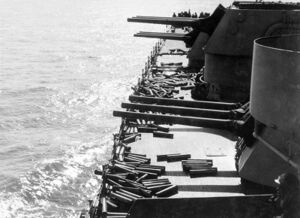Cacertian 150mm RN-QF Naval Gun
This article is incomplete because it is pending further input from participants, or it is a work-in-progress by one author. Please comment on this article's talk page to share your input, comments and questions. Note: To contribute to this article, you may need to seek help from the author(s) of this page. |
| Royal Navy Quick-Firing Mark I (RN-QFI) | |
|---|---|
 Three forward turrets and empty cartridge cases on HMS Ostium during the Siduri War | |
| Type | Naval gun |
| Place of origin | |
| Service history | |
| In service | 1919 – present |
| Used by | |
| Wars | Siduri War Refusal War FedCom Civil War |
| Production history | |
| Designed | 1917 |
| Manufacturer | CNRC Ordnance Bureau |
| Produced | 1918 – 1976 |
| Variants | QFII, QFIII, QFIV |
| Specifications | |
| Weight | 5.9 tons |
| Length | 7.6 meters |
| Barrel length | 7.2 meters |
| Shell | Separate-loading, case charge |
| Shell weight | AP: 59 kg HE: 48 kg |
| Caliber | 150 mm |
| Action | Semi-automatic, vertical sliding-wedge |
| Elevation | -5° to 50° in most turret housings |
| Traverse | Up to 360° |
| Rate of fire | 10 rpm |
| Muzzle velocity | 960 m/s |
| Effective firing range | 19,000 meters with 59 kg AP shell at 22.3° elevation |
| Maximum firing range | 25,700 meters at 40° elevation |
The Royal Navy Quick-Firing Mark I was a Cacertian medium-caliber naval gun developed in the late 1910s that saw extensive service in the Cacertian Royal Navy. RN-QFs served as the primary armament aboard several cruiser classes and as the secondary armament on many battleships. The most important advancement that came out of the development of the RN-QF series was the refinement of semi-automatic loading technologies which allowed the guns to possess a maximum rate of fire of ten rounds per minute; the auto-loading technology would be further developed for larger caliber naval guns. Housed in double and triple turrets, the RN-QF series could engage both surface and air targets which made it one of the most produced and most capable armaments of the CRN to date.
Description
The 150mm RN-QF guns were already undergoing the development phase even before the conclusion of the Divide War. Future Grand Admiral Andrea Doria and ship designer Eugenia Davion both approached the CNRC Ordnance Bureau and met with gun developer Arria Padova with the request to develop a new armament with which to mount on future cruiser and battleship designs. The first iteration of the QF was tested in October 1917.
Initial production RN-QF Mark Is could fire a 59 kg projectile approximately 19,000 meters at 22.3° elevation with a flight time of 44.7 seconds; the maximum measured firing range was conducted with a 48 kg HE shell and reached a distance of 25,700 meters at a 40° elevation and a flight time of 77.3 seconds. Armor-piercing projectiles weighed 59 kg and high-explosive weighed 48 kg. HE projectiles could be fitted with proximity fuses and mechanical timers which allowed them to be used against aircraft.
With their semi-automatic loading mechanisms, a RN-QF was capable of firing 8 to 10 rounds a minute; the life expectancy of a gun barrel was 750 to 1,050 full-charge rounds.
Mounts
Given the variable capabilities of the RN-QF series, guns were mounted in a variety of different turrets. Dual turrets were most commonly found on light cruisers, with the exception of the Padua-class which was instead armed with triple-gun turrets that were more likely found on standard cruisers. As secondary armaments, QFs were also mounted in dual turrets.
Three-gun turrets were mostly designed to combat surface targets with all three guns mounted on the same sleeve and thus elevated and depressed together. Dual turrets, which were instead developed for dual-purpose applications, could elevate their guns to steeper angles as well as train faster and fire more quickly.
Service History
The RN-QF series and its variants was the primary armament aboard most cruiser designs of the post-Divide War Era. This included the Brindisi, Savina, and Padua classes of light cruisers as well as the Romana, Scarano, and Molfetta classes of cruisers.
Alongside serving extensively in Cacerta’s cruiser force, their dual-purpose capabilities also saw them implemented a secondary anti-surface and anti-aircraft armaments for most battlecruisers and battleships.